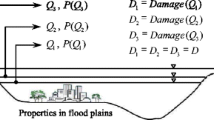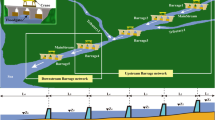Abstract
Many problems occur in plain river networks, such as low river flow and severe water environment pollution. Water diversion is important for water environment improvement in plain river network areas. Adopting Sanshanwei in Foshan city as an example, a river network hydrodynamic and water quality coupling model was constructed based on structural optimization technology for complex gate-controlled tidal river networks. Fifteen-day continuous hydrodynamic water quality monitoring data were used for model validation. Two model performance evaluation indices, NSE and RMSE, were employed for model reliability evaluation. Considering terrain, tidal pattern and landscape water level, five optimal scheduling conditions (C1-C5) were designed. The hydrodynamic water quality improvement effect was simulated under different working conditions, and the comprehensive influence mechanisms of tide level, drainage flow and spatial distribution, water quality and river water level were examined. Water pollution was evaluated by a single-factor pollution index. The results indicated a reasonable and reliable model. The river network structure optimization method is universal. Under C1 to C5, the average pollutant reduction rates in the monitoring section were 28.69%, 34.05%, 0.77%, -44.49% and -144.69%. The river network water environment was improved under C1, C2 and C3, from Moderate pollution to Light, Mminor and Light pollution respectively. A river section with high water quality requirements should be used as the upstream section of the water replenishment path. Comprehensively considering the effects of river flow distribution, flow path, branch river diversion and outer river pollutant concentration on river water quality, and combining the dynamic water environment capacity of the tidal river network and spatial and temporal distributions of pollution source discharge, the water environment improvement effect was high significant. These results provide important technical support for water environment management in gate-controlled plain river network areas eliminate black and odorous urban water bodies.












Similar content being viewed by others
Availability of Data and Materials
The data and code that support the study are available from the corresponding author upon reasonable request.
References
Bu J, Zhang S, Li C, Xu X, Wang X, Liu Q, Wang X (2022) A longitudinal functional connectivity comprehensive index for multi-sluice flood control system in plain urban river networks. J Hydrol 613:128362. https://doi.org/10.1016/j.jhydrol.2022.128362
Camenen B, Gratiot N, Cohard JA, Gard F, Tran VQ, Nguyen AT, Dramais G, van Emmerik T, Némery J (2021) Monitoring discharge in a tidal river using water level observations: Application to the Saigon River, Vietnam. Sci Total Environ 761:143195. https://doi.org/10.1016/j.scitotenv.2020.143195
Chen Z, Ding Y, Mao X, Wang Z, Jia H (2017) Source identification of accidental water pollution in a tidal river network based on a water environment model and database. J Tsinghua Univ Sci Technol 57(11):1170–1178. https://doi.org/10.16511/j.cnki.qhdxxb.2017.21.034. (In Chinese)
Feng L, Li Q, Zhang L, Wang H, Wang W, Han J, Li B (2021) Exploring the effect of floodgates operation systems on water environmental capacity in a regulated river network of Wuxi. China J Clean Prod 299:126743. https://doi.org/10.1016/j.jclepro.2021.126743
Gu Z, Cao X, Liu G, Lu W (2014) Optimizing operation rules of sluices in river networks based on knowledge-driven and data-driven mechanism. Water Resour Manag 28(11):3455–3469. https://doi.org/10.1007/s11269-014-0679-y
Guo X, Cheng S, Li Z, He W, Kou X, Qiao X, Wang C (2023) Regulation optimization of tidal river gates for water environment improvement in the river basins: a case study on independent polders’ river networks. Environ Eng 41(03):49–56. https://doi.org/10.13205/j.hjgc.202303007. (In Chinese)
Gullotta A, Aschale T, Peres D, Sciuto G, Cancelliere A (2023) Modelling stormwater runoff changes induced by ground-mounted photovoltaic solar parks: a conceptualization in EPA-SWMM. Water Resour Manag 37:4507–4520. https://doi.org/10.1007/s11269-023-03572-3
Hu Z, Wang L, Tang H, Qi X (2017) Prediction of the future flood severity in plain river network region based on numerical model: A case study. J Hydrodyn 29:586–595. https://doi.org/10.1016/S1001-6058(16)60771-0
Islam MF, Middelkoop H, Schot PP, Dekker SC, Griffioen J (2020) Enhancing effectiveness of tidal river management in southwest Bangladesh polders by improving sedimentation and shortening inundation time. J Hydrol 590. https://doi.org/10.1016/j.jhydrol.2020.125228
Jiang T, Zhu S, Zhang Q, Chen X (2011) Numerical simulation on effects of gate-pump joint operation on water environment in tidal river network. J Hydraul Eng 42(04):388–395. https://doi.org/10.13243/j.cnki.slxb.2011.04.003. (In Chinese)
Li B, Yang G, Wan R, Lai X, Wagner PD (2022) Impacts of hydrological alteration on ecosystem services changes of a large river-connected lake (Poyang Lake), China. J Environ Manag 310:114750. https://doi.org/10.1016/j.jenvman.2022.114750
Ren L, Song S, Zhou Y (2022) Evaluation of river ecological status in the plain river network area in the context of urbanization: A case study of 21 Rivers’ ecological status in Jiangsu Province, China. Ecol Indic 142:109172. https://doi.org/10.1016/j.ecolind.2022.109172
Li Y, Wang H, Deng Y, Liang D, Li Y, Gu Q (2023) Applying water environment capacity to assess the non-point source pollution risks in watersheds. Water Res 240:120092. https://doi.org/10.1016/j.watres.2023.120092
Liu YH, Yang ZL, Lin PR (2023) Parallel river channel routing computation based on a straightforward domain decomposition of river networks. J Hydrol 625:129988. https://doi.org/10.1016/j.jhydrol.2023.129988
Ma K, Tu X, Chen X (2021) simulation of water quantity and quality response of sluice operation in sluice controlled river network area. J China Hydrol 41(06):66–72. https://doi.org/10.19797/j.cnki.1000-0852.20200507. (In Chinese)
Matta G, Kumar A, Nayak A, Kumar P (2022) Appraisal of spatial–temporal variation and pollution source estimation of Ganga River system through pollution indices and environmetrics in Upper Ganga basin. Appl Water Sci 12:1–11. https://doi.org/10.1007/s13201-021-01552-9
McBrayer A, Brickey A (2023) A review of current scheduling and design practices in the powder river basin. Mining Metall Explor 40:1059–1080. https://doi.org/10.1007/s42461-023-00754-w
Nash JE, Sutcliffe JV (1970) River flow forecasting through conceptual models part I—A discussion of principles. J Hydrol 10(3):282–290. https://doi.org/10.1016/0022-1694(70)90255-6
Nayak A, Matta G, Prasad Uniyal D, Kumar A, Kumar P, Pant G (2023) Assessment of potentially toxic elements in groundwater through interpolation, pollution indices, and chemometric techniques in Dehradun in Uttarakhand State. Environ Sci Pollut Res. https://doi.org/10.1007/s11356-023-27419-x
Pan H, Li Y, Tang C, Kumud A, Yao X, Zhang J, Zhu Y, Cheng Y, Cheng Y, Yu S, Yue Z (2021) Evaluation of the effect of water diversion on improving water environment in plain river network under the multi-objective optimization. J Lake Sci 33(04):1138–1152. https://doi.org/10.18307/2021.0415. (In Chinese)
Singh J, Knapp HV, Arnold JG, Demissie M (2005) Hydrological modeling of the Iroquois River watershed using HSPF and SWAT. JAWRA J Am Water Resour Assoc 41(2):343–360. https://doi.org/10.1111/j.1752-1688.2005.tb03740.x
Tang H, Yuan S, Cao H (2023) Theory and practice of hydrodynamic reconstruction in plain river networks. Engineering 24:202–211. https://doi.org/10.1016/j.eng.2022.01.015
Wang H, Zhang W, Li Y, Gao Y, Niu L, Zhang H, Wang L (2023) Hydrodynamics-driven community coalescence determines ecological assembly processes and shifts bacterial network stability in river bends. Sci Total Environ 858. https://doi.org/10.1016/j.scitotenv.2022.159772
Xiang Z, Wu S, Zhu L, Yang K, Lin D (2023) Pollution characteristics and source apportionment of heavy metal(loid)s in soil and groundwater of a retired industrial park. J Environ Sci. https://doi.org/10.1016/j.jes.2023.07.015
Xu Y, Li Y, Luo Y, Yu X, Jiang J, Luo F (2019) Effect evaluation of water diversion to water quality improve in plain tidal river network. Water Resour Protect 35(06):124–130. https://doi.org/CNKI:SUN:SZYB.0.2019-06-019. (In Chinese)
Yin H, Lin Y, Xu Z, Wang X, Shi Z, Lu Y (2020) Mathematical model for wet-weather black-odorous water bodies treatment in tidal river network, Chinese. J Hydrodynam 35(01):113–121. https://doi.org/10.16076/j.cnki.cjhd.2020.01.017. (In Chinese)
Yu P (2022) Experimental research of movement characteristics of water and sediment and channel evolution in the multi-branch reach-An example of the Dongliu Waterway, China. Wuhan University. https://doi.org/10.27379/d.cnki.gwhdu.2019.001830. (In Chinese)
Yu R, Zhang C, Gao X, Daly K (2023) Stagnant water environmental management in urban river networks: An integrated risk analysis involving hydraulic potential dissipation. J Hydrol 622:129652. https://doi.org/10.1016/j.jhydrol.2023.129652
Zhang X, Qiao W, Huang J, Li H, Wang X (2023) Impact and analysis of urban water system connectivity project on regional water environment based on Storm Water Management Model (SWMM). J Clean Prod 423:138840. https://doi.org/10.1016/j.jclepro.2023.138840
Funding
This work is partly supported by the National Natural Science Foundation of China (No. 52079106); Chinesisch-Deutsches Mobilitätsprogramm (No. M-0427), Key R&D Program of Shaanxi of China "Key Technology and Industrialization of Sustainable Management of Flood Disaster" (2023GXLH-042), the Natural Science Foundations of Shaanxi Province (No. 2022JC-LHJJ-09),Key science and technology projects of Power China (DJ-ZDXM-2022–41), and Major company-level science and technology projects of Northwest Engineering Corporation Limited, Power China (XBY-ZDKJ-2022–9).
Author information
Authors and Affiliations
Contributions
Jingming Hou: Conceptualization, Methodology; Guangxue Luan: Software, Data curation, Writing-Original draft preparation. Wang Tian: Visualization, Investigation; Jiahao Lv: Supervision; Yuzhe Li: Supervision; Xujun Gao: Supervision; Xuelaing Sun: Supervision; Yuan liu: Supervision.
Corresponding authors
Ethics declarations
Ethical Approval
Informed consent.
Consent to Participate
Not applicable.
Consent to Publish
The authors are indeed informed and agree to publish.
Competing Interests
We declare that we have no financial and personal relationships with other people or organizations that can inappropriately influence our work, there is no professional or other personal interest of any nature or kind in any product, service and company that could be construed as influencing the position presented in, or the review of, the manuscript entitled “Research of hydrodynamic and water quality optimization scheduling based on the optimization technology of complex of river network structure”.
Additional information
Publisher's Note
Springer Nature remains neutral with regard to jurisdictional claims in published maps and institutional affiliations.
Rights and permissions
Springer Nature or its licensor (e.g. a society or other partner) holds exclusive rights to this article under a publishing agreement with the author(s) or other rightsholder(s); author self-archiving of the accepted manuscript version of this article is solely governed by the terms of such publishing agreement and applicable law.
About this article
Cite this article
Luan, G., Hou, J., Wang, T. et al. Research on Hydrodynamic and Water Quality Optimization Scheduling Based on Optimization Technology for Complex of River Network Structures. Water Resour Manage 38, 1339–1358 (2024). https://doi.org/10.1007/s11269-023-03724-5
Received:
Accepted:
Published:
Issue Date:
DOI: https://doi.org/10.1007/s11269-023-03724-5




